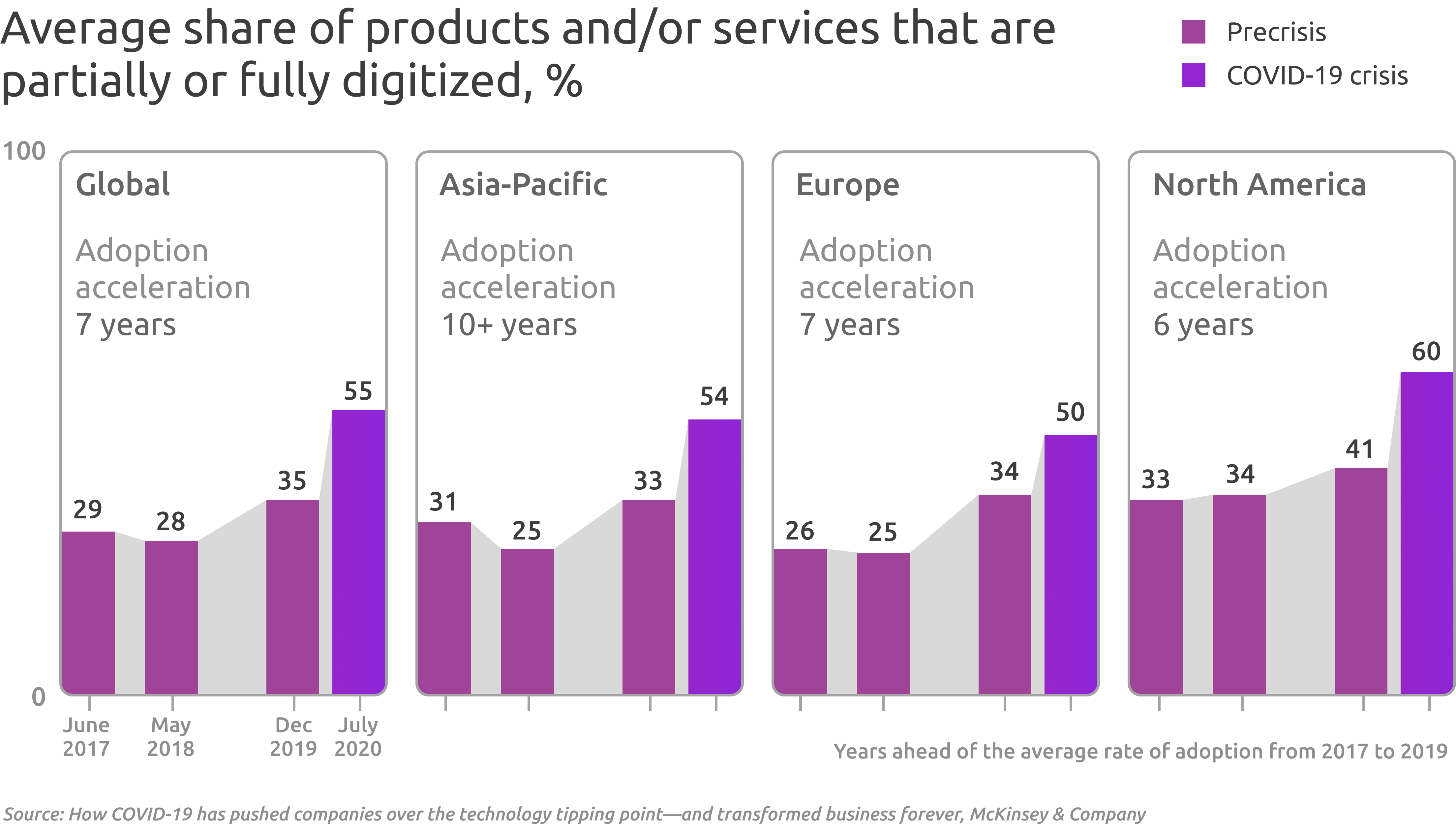Building a future-ready enterprise: The journey to digital transformation
Technology constantly changes, and companies must stay on top of these changes to compete in the industry. This is where the terms digitization, digitalization, and digital transformation, and the difference between them assume significance.
Straight to the point, the three terms may sound similar, but they do not mean the same thing.
They are, however, connected. They are chronological steps in an organization’s quest to reach a digital maturity that allows it to quickly adapt to changing business environment or in the face of unexpected challenges.
What's important is how the industry and business-related processes can leverage these steps to create new value-driving opportunities and improve the efficiency of their operations.
In this article, we'll look at the broad steps needed to drive digital transformation.
The importance of driving digital transformation
The world is changing rapidly, and companies that fail to adapt risk being left behind. Among other industries, this is especially true in the oil and gas industry, where technological advances are revolutionizing things and transforming the existing business model.
With the help of digital transformation efforts, companies can streamline processes, reduce costs, increase efficiency, and improve customer satisfaction and workflows.
But it's not just about keeping up with the competition – digital transformation also means adapting quickly when unexpected challenges arise. The COVID-19 pandemic showed the importance of being agile in times of crisis. Companies that could quickly adapt to remote work environments or shift production lines were better prepared than those that could not. Using digital tools and leveraging automation was crucial in enabling such adaptability.
McKinsey & Company's research clearly showed how the pandemic accelerated the digitization process:

In short, the digital transformation journey isn't just a nice trip; it's essential to survival in today's changing business models. By investing in technology and innovation now, gas companies can ensure their long-term success while meeting the needs of their clients now and in the future.
This change is a leap into the deep waters, an endeavour that will benefit from taking smaller but strategic steps: From digitization to full digital transformation. Let's have a closer look at each of these steps.
Digitization: Transforming what’s analog into digital
Simply put, the term ‘digitization’ refers to the process of converting analog information into digital form. This means taking physical documents, images, or sound recordings and turning them into digital ones that can be conveniently stored, processed, and transmitted.
This first stage of the modernization journey is a technical process that improves efficiency and accuracy.
The process of digitization involves scanning or capturing the data from its original form using specialized equipment. Once captured, the data is stored in a digital format, like a database, PDFs, JPEGs, etc. The digital document can then be accessed electronically and shared across devices and platforms.
Digitization allows for sharing of information efficiently and securely, making it a valuable tool for businesses, governments, and individuals.
The core business processes do not change here; they just become more efficient due to the reduction or elimination of manual inputs, yielding more accurate outcomes.
Digitization provides easier access to data by reducing the reliance on physical storage space and enabling remote access through online databases (especially in the cloud).
Digitizing paper documents eliminates the risks of damage or loss associated with physical records. Additionally, digitized data can be easily backed up and secured, ensuring its availability and integrity.
This streamlined access to information enhances operational efficiency, facilitates quick decision-making, and enables seamless team collaboration.
Digitalization: Using digital technologies to improve business processes
Digitalization is leveraging digitized data and technology to streamline, automate and optimize business processes, and create new opportunities.
This stage helps improve efficiency and the customer experience.
Here, technology starts changing how work gets done or how products are delivered, often creating new opportunities.
Companies can use digitalization by adopting software that automates inventory management, order processing, and billing operations.
The digital world has created new possibilities for organizations, letting them collect and analyze massive amounts of data like never before. This information can provide priceless insights into customer behaviour, market trends, and operational effectiveness.
By leveraging the potential of digital tools, companies can make smarter decisions that drive future growth and adapt their strategies to the changing market landscape.
Adopting modern business processes and models that integrate the Internet of Things (IoT) can improve data collection and analysis, enabling companies to unlock even deeper insights and optimize their operations.
Digital transformation: Transforming business in the digital age
Digital transformation is the ultimate goal of any business that wants to stay ahead of the competition.
This step is a holistic and more strategic level of change that involves rethinking and reinventing the way an organization operates. It involves leveraging improvements made in the digitization and digitalization stages to enable a fundamental shift in how a business delivers value.
A key benefit of digital transformation initiatives is that it enables companies to operate more effectively in a rapidly changing market environment.
For example, companies can free up time for employees to focus on more strategic initiatives by implementing automated processes such as chatbots or virtual assistants that can handle repetitive tasks and provide real-time customer support.
The bottom line is that digital transformation takes a major investment of time – it should be viewed as an ongoing process, not a one-time event.
Organizations must proactively adopt new technologies to remain relevant in today's dynamic and competitive landscape. They can do so by fully embracing this step-by-step approach across all functions.
Share this
You May Also Like
These Related Stories

The Playbook: Driving digital transformation at medium-large enterprises

Bridging the gap between legacy systems and digital innovation
